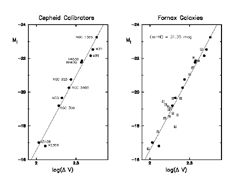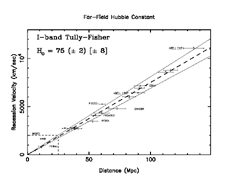


Quite independent of its association with the Fornax cluster as a whole, NGC 1365 provides an important calibration point for the Tully-Fisher relation which links the (distance-independent) peak rotation rate of a galaxy to its intrinsic luminosity. In the left panel of Figure 35 we show NGC 1365 (in addition to NGC 925 (Silbermann et al. 1996), NGC 4536 (Saha et al. 1996) and NGC 4639 (Sandage et al. 1996) added to the ensemble of calibrators having published Cepheid distances (Freedman 1990), and I-band magnitudes (Pierce 1994 and references therein). As mentioned earlier, NGC 1365 does now provide the brightest data point in the relation; additional galaxies soon to be added include NGC 2090 (Phelps 1997), NGC 3351 (Graham 1997) and NGC 3621 (Rawson 1997).
Although we have only the Fornax cluster for comparison at the present
time, it is interesting to note that there is no obvious discrepancy
in the Tully-Fisher relation between galaxies in the (low-density)
field and galaxies in this (high-density) cluster environment. The
NGC 1365 data point is consistent with the data for
other Cepheid
calibrators. Adding in all of the other Fornax galaxies for which
there are published I-band magnitudes and inclination-corrected HI
line widths provides us with another comparison of field and cluster
spirals. In the right panel of Figure 36 we
see that the 21 Fornax
galaxies (shifted by the true modulus of NGC 1365) agree extremely
well with the 9 brightest Cepheid-based calibrators. The slope of the
relation is virtually unchanged by this augmentation; with the scatter
about the fitted line increasing somewhat to ± 0.35 mag.
(Nevertheless, the small intrinsic scatter in the relation greatly
diminishes the impact of Malmquist-bias.) In the following applications
we adopt MI = -8.80 log( V - 2.445) + 20.47 as the
best-fitting least squares solution for the calibrating galaxies.
V - 2.445) + 20.47 as the
best-fitting least squares solution for the calibrating galaxies.
 Figure 35. Tully-Fisher relations. The
left panel shows the absolute I-band magnitude, MI
versus the inclination-corrected 21-cm line widths for galaxies having
individually determined Cepheid distances. NGC 1365 is the brightest
object in this sample; the position of this cluster spiral is
fully consistent with an extrapolation of the relation defined by the
lower luminosity field galaxy sample. The right panel shows the
calibrating sample (filled circles) superimposed on the entire
population of Fornax spiral galaxies for which I-band observations
and
line widths are available; the latter being shifted to absolute
magnitudes by the Cepheid distance to NGC 1365.
Figure 35. Tully-Fisher relations. The
left panel shows the absolute I-band magnitude, MI
versus the inclination-corrected 21-cm line widths for galaxies having
individually determined Cepheid distances. NGC 1365 is the brightest
object in this sample; the position of this cluster spiral is
fully consistent with an extrapolation of the relation defined by the
lower luminosity field galaxy sample. The right panel shows the
calibrating sample (filled circles) superimposed on the entire
population of Fornax spiral galaxies for which I-band observations
and
line widths are available; the latter being shifted to absolute
magnitudes by the Cepheid distance to NGC 1365.
Han (1992) has presented I-band photometry and neutral-hydrogen line widths for the determination of Tully-Fisher distances to individual galaxies in 16 clusters out to redshifts exceeding 10,000 km/sec. We have rederived distances and uncertainties to each of these clusters using the above-calibrated expression for the Tully-Fisher relation. The results are contained in Figure 36, where a linear fit to the data gives a Hubble constant of H0 = 76 km/sec/Mpc with a total observed scatter giving a formal (random) uncertainty on the mean of only ± 2 km/sec/Mpc. It is significant that neither Fornax nor Virgo deviate to any significant degree from an inward extrapolation of this far-field solution. At face value, these results provide evidence for both of these clusters having only small motions with respect to their local Hubble flow.
 Figure 36. The velocity-distance
relation for 16
clusters of galaxies out to 11,000 km/sec, having distance moduli
determined from the I-band Tully-Fisher relation. A fit to the data
gives a Hubble constant of H0 = 76 ± 2
km/sec/Mpc. The solid lines mark one-sigma bounds on the observed
internal scatter.
Figure 36. The velocity-distance
relation for 16
clusters of galaxies out to 11,000 km/sec, having distance moduli
determined from the I-band Tully-Fisher relation. A fit to the data
gives a Hubble constant of H0 = 76 ± 2
km/sec/Mpc. The solid lines mark one-sigma bounds on the observed
internal scatter.